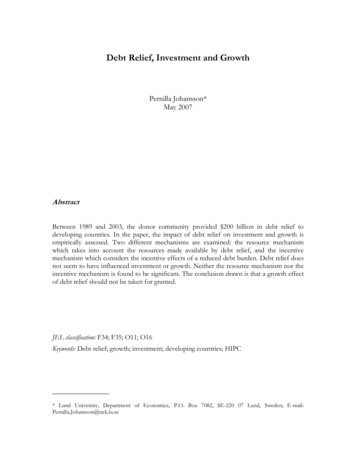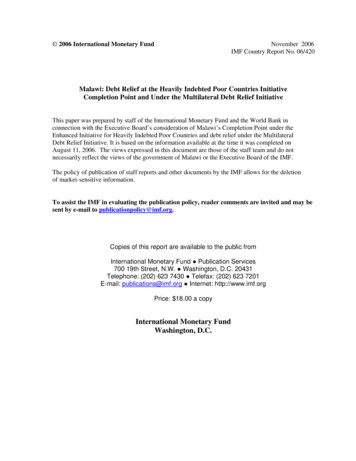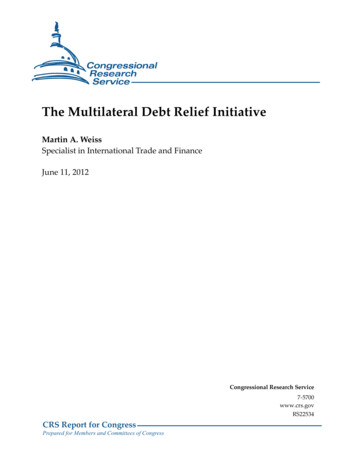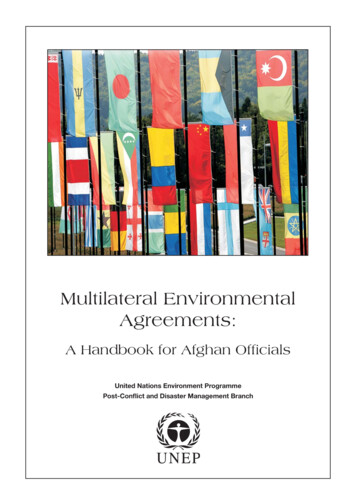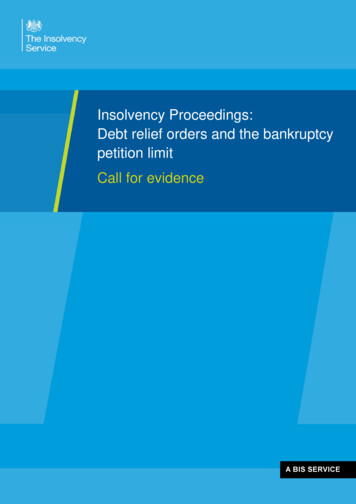
Transcription
Public Disclosure AuthorizedP olicy R esearch W orking P aperPublic Disclosure Authorized4872Multilateral Debt Relief through the Eyesof Financial MarketsClaudio RaddatzPublic Disclosure AuthorizedPublic Disclosure AuthorizedWPS4872The World BankDevelopment Research GroupMacroeconomics and Growth TeamMarch 2009
Policy Research Working Paper 4872AbstractThe economic benefits of debt relief for recipientcountries have been the subject of arduous debate, atleast partly motivated by the difficulty of identifying thecausal effect of debt relief on economic performance—given that performance itself may drive the decisionto grant relief. This paper conducts an event study toassess the economic consequences of multilateral debtrelief for recipient countries that is robust to thesereverse causality issues. It estimates the response ofthe stock prices of South African multinationals withsubsidiaries in those countries to the announcementof debt relief initiatives, and shows that stock pricesexhibit a significant increase above those of other firms,especially around the launching of the recent MultilateralDebt Relief Initiative. The improvement in financialmarkets' assessment of the value of these multinationals isconsistent with lower expected levels of future taxation inthe recipient countries. Overall, the results are consistentwith the “debt overhang” argument for debt relief.This paper—a product of the Growth and the Macroeconomics Team, Development Research Group—is part of a largereffort in the department to assess the economic impact of debt relief in recipient countries. Policy Research Working Papersare also posted on the Web at http://econ.worldbank.org. The author may be contacted at craddatz@worldbank.org.The Policy Research Working Paper Series disseminates the findings of work in progress to encourage the exchange of ideas about developmentissues. An objective of the series is to get the findings out quickly, even if the presentations are less than fully polished. The papers carry thenames of the authors and should be cited accordingly. The findings, interpretations, and conclusions expressed in this paper are entirely thoseof the authors. They do not necessarily represent the views of the International Bank for Reconstruction and Development/World Bank andits affiliated organizations, or those of the Executive Directors of the World Bank or the governments they represent.Produced by the Research Support Team
Multilateral Debt Relief through the Eyes of Financial MarketsClaudio Raddatz The World BankAbstractThe economic bene ts of debt relief for recipient countries have been the subject of arduousdebate, at least partly motivated by the di culty of identifying the causal e ect of debt relief oneconomic performance given that performance itself may drive the decision to grant relief. Thispaper conducts an event study to assess the economic consequences of multilateral debt relieffor recipient countries that is robust to these reverse causality issues. It estimates the responseof the stock prices of South African multinationals with subsidiaries in those countries to theannouncement of debt relief initiatives, and shows that stock prices exhibit a signi cant increaseabove those of other rms, especially around the launching of the recent Multilateral Debt ReliefInitiative. The improvement in nancial markets' assessment of the value of these multinationalsis consistent with lower expected levels of future taxation in the recipient countries. Overall,the results are consistent with the debt overhang argument for debt relief.E-mail address: craddatz@worldbank.org. I am extremely grateful to Shinsuke Uchida for superb research assistance. I am also grateful to those South African multinational companies that gently provided information for thisproject: ABSA Group Ltd., Astral Foods Ltd., Bell Equipment Ltd., Blue Financial Services Ltd., Illovo Sugar Ltd.,and MTN Group Ltd. Comments from seminar participants at the University of Chile, LACEA, and the World Bankare also gratefully acknowledged. All remaining errors are my responsibility. Financial support from the JapaneseCTF is gratefully acknowledged. The views expressed in this paper are the author's only and do not necessarilyrepresent those of the World Bank, its Executive Directors, or the countries they represent.
1IntroductionOn July 8th 2005, the Heads of State and Government of the G8 meeting in Gleneagles, UK,announced the launching of theMultilateral Debt Relief Initiative MDRI(), where they agreed tocancel the historical debt of the world poorest countries with the International Monetary Fund,the World Bank, and the African Development Bank. Since multilateral institutions had becomethese countries' main creditors, the initiative, with an estimated debt write-o of 50 bn, or about70 percent of these countries' total stock of debt was expected to provide substantial debt relief(International Development Agency and International Monetary Fund (2006)).However, whatthe broader public probably does not know is that, although drawing broader media coverageand celebrity attention than its predecessors, the MDRI is just the latest incarnation of a seriesof e orts to relieve poor countries' nancial obligations with multilateral institutions through theHeavily Indebted Poor Countries HIPC() initiative, set in motion in 1996 and modi ed ( enhanced )in 1999.There are clear humanitarian motives for debt relief that are behind numerous calls from religiousleaders, celebrities, and intellectuals arguing that it is morally wrong to collect debt from countriesthat are at the brink of starvation.However, the case for debt relief is also typically argued onthe grounds that current debt burdens maintain poor countries in a situation ofdebt overhang,where socially and privately pro table investment opportunities are foregone because of the implicittax on their returns imposed by previous debt obligations (Krugman (1988); Sachs and Calvo(1989)). Firms anticipating the high future taxes required to service a massive debt burden maynd unpro table certain investment projects that they would otherwise nance, and governmentsmay be reluctant to incur costly reforms if a large part of their returns would go to foreign creditors.Since according to the debt overhang argument, debt relief should be associated with increasedprivate and social investment and better macroeconomic performance, many researchers have lookedfor the impact of debt relief on growth and investment. However, nding causal evidence of thisimpact using aggregate data is di cult because countries that receive debt relief are not random;countries with extremely high levels of debt and bad economic performance are more likely to receiveit.Therefore, one could nd a negative correlation between debt relief and growth in aggregatedata, even if it actually improves the prospects of countries that receive it. Of course, it may alsobe the case that countries with good economic prospects get debt relief, in whose case nding apositive correlation between debt relief and economic performance does not provide evidence thatthe former causes the latter. Moreover, even if there is a causal link, debt relief will likely a ecteconomic performance with a delay that di cults the identi cation of the impact using time seriesvariation. For these reasons, evidence based on aggregate data has to either just report correlationsor depend on strong identi cation assumptions.This paper provides new evidence of the impact of multilateral debt relief initiatives using anevent-study to determine the e ect of these initiatives on rms with operations in the countries theybene ted. This approach has several advantages over studies based on aggregated data, becauseit is much less likely to be a ected by reverse causality, and also takes advantage of the forward1
looking nature of stock prices to deal with the timing problems. The approach relies on the standardassumption that stock prices quickly re ect the market's view of the impact of these initiatives onthe value of rms that operate in these countries, so, if these rms' values improve as a consequenceof debt forgiveness, there should be an abnormal increase in their stock prices around major debtrelief announcements.Debt relief can impact the value of rms operating in bene ted countries through two channels.The rst is through an improvement in the country's economic prospects. Debt relief may inducelocal governments to allocate more resources to public goods or human capital formation, or mayincrease private investment, resulting in higher economic growth. To the extent that the value ofrms with operations in those countries is positively correlated with the state of aggregate demand,future economic expansion would increase their value.for future taxation.The second channel is the reduced needAbsent severe contractions in public expenditure, repaying large levels ofpublic debt likely requires a high level of taxation.In poor countries, where income taxes arehard to impose, these taxes tend to fall on companies.1Therefore, as long as markets assign apositive probability to the repayment of the debt, the relief should reduce expected taxation andincrease rm value. If any of these channels is in operation, an event study on the behavior of theshare prices of publicly traded companies operating in HIPC countries around dates of debt reliefannouncements provides an indirect test of the hypothesis that debt relief has a positive e ect oneconomic performance .Since HIPC countries typically lack well functioning and liquid stock markets, this paper followsGuidolin and La Ferrara (2007) and studies the response of the stock prices of multinational rmswith subsidiaries and operations on HIPC countries, but that are traded in foreign, more developednancial markets. In particular, it focuses on South African multinational companies traded in theJohannesburg Stock Exchange (JSE), which is a one of the largest and most active emerging stockmarkets, and where it is possible to obtain meaningful price data at a daily frequency. Focusing onSouth African multinationals has the additional advantage that these companies are smaller thanglobal multinationals operating in African HIPC countries.Therefore, their operations in thesecountries are relatively more important and their share prices more likely to respond to eventsa ecting their subsidiaries.2To implement this approach, I build a detailed chronology of the multilateral debt relief initiatives that allows me to identify the dates of di erent announcements related to the three majorinitiatives implemented since 1996 (HIPC, Enhanced HIPC, and MDRI), including the dates whenindividual countries reached any of the milestones considered in the HIPC framework (decisionpoints and completion points).I also gather stock price data for a sample of 35 South Africanmultinational companies with 187 subsidiaries and operations in African HIPC countries during the1According to World Bank (2008) Paying Taxes Report, Sub-Saharan Africa is the continent with the highestoverall business taxes, including the highest average pro t taxes.2Large global multinationals, such as Unilever, have operations in several African HIPC countries. However, itis unlikely that Unilever's stock price in the London Stock Exchange would vary importantly as a result of eventsa ecting a marginal operation in Kenya. In contrast, operations in HIPC countries, while small, are not marginal forSouth African multinationals.2
period 1995-2006 when the various stages of the initiatives took place. I use these data to estimatea two-factor return model and measure the abnormal returns of these companies around the datesof the announcements, and to formally test the hypothesis that these abnormal returns are equalto zero applying various parametric and non-parametric procedures.The results show that stock prices of South African multinationals with operations in HIPCeligible African countries exhibit an abnormal and statistically signi cant increase around the announcement dates of major debt relief initiatives. The magnitude of the increase is also economicallysigni cant, with the announcements resulting in a cumulative abnormal return of about one percentage point for the typical parent company. Considering that the parent companies are usually atleast an order of magnitude larger than their a ected subsidiaries, these results suggest a two-digitcumulative impact on the value of local operations.Evidence comparing the various stages of multilateral debt relief programs indicates that the latest phases (enhanced HIPC and MDRI) had a larger impact on HIPC connected multinational companies than the original HIPC initiative. Also, country-speci c announcements about the achievement of the various milestones of the broad HIPC program (decision and completion points) havelittle impact on rms' returns, although there is some evidence that reports of a country reachingcompletion point positively impact the stock prices of related multinationals.Furthermore, thestock price response takes place mainly around the formal announcements of the launching of themajor initiatives in the G8 Summit Meetings, with little evidence of stock reactions around theAnnual Meetings of the World Bank and International Monetary Fund, where the nal details ofthe implementation are disclosed.Consistently with the interpretation that the increase in stock prices is related to nancial market's reassessment of the value of rms operating in countries bene ted by debt relief programs, theincrease in stock returns is larger among South African multinational companies that are relativelymore exposed to the events, as measured by the total employment in subsidiaries located in eligiblecountries as a fraction of the employment of the parent company. This comparison further strengthens the causal interpretation of the ndings, since it implicitly controls for any potential commone ect a ecting all companies with operations in HIPC countries , or multinational rms in general.The stock price response to major debt relief announcements of parent companies in di erentindustries suggests that the underlying increase in value is mainly related to the expectation oflower future taxes rather than improved economic prospects.Companies in resource extractionindustries, which are more likely to be the target of taxation and are less dependent on localeconomic conditions, exhibit a signi cantly larger stock price increase than companies in serviceindustries where the relevance of local economic conditions vis-a-vis taxes reverses.This ndingalso indicates that the stock price response is not a mechanical response to potential real exchangerate appreciation associated with debt forgiveness (Rajan and Subramanian (2005a), Rajan andSubramanian (2005b)).Overall, the evidence presented in this paper suggests that nancial markets view the announcements of major debt relief initiatives as positive news for rms operating on these countries, resulting3
most likely from a reduction in expected taxes, and support the debt overhang hypothesis of thecosts of excessive debt.This paper relates to the empirical literature on sovereign debt overhang and on the impact ofdebt relief.Several papers in this literature have used aggregate data to test the debt overhanghypothesis by looking at the relation between debt levels and growth or investment (Claessens(1990), Deshpande (1997) Cordella et al. (2005), Imbs and Ranciere (2005)) and have identi eddi erent thresholds over which debt burden is negatively correlated with growth, and in some casesfurther thresholds above which debt has no growth e ect (Cordella et al. (2005)). A slightly di erentline of research has been followed by Depetris-Chauvin and Kraay (2005), who instead of looking atthe relation between debt levels and macroeconomic performance directly study the growth e ectof debt relief, nding little evidence that countries experiencing relatively larger reductions in theirstock of debt tend to grow faster. While providing interesting results, the main concern with allthese papers is that their reliance on aggregate data exposes them to the econometric problemsarising from reverse causality and from debt relief not being randomly assigned to countries, andthat they have to rely on various econometric techniques and strong identi cation assumptions tomove from correlation to causality.Indirect, but stronger evidence on the impact of debt relief has recently been provided byArslanalp and Henry (2005), who also use an event study approach to show that stock marketsindexes of countries bene ted by the Brady Plan signi cantly increased relative to a control groupafter the announcement of the plan. However, since HIPC countries typically lack stock marketsArslanalp and Henry (2005) do not apply their methodology to estimate the impact of the HIPCinitiative, and rely instead on indirect arguments to conjecture that HIPC countries are unlikely tobene t from the type of debt relief provided by the Brady Plan because investment in these countriesis not constrained by debt overhang but for bad institutions (Arslanalp and Henry (2006)).Anadditional concern with this paper is that, by looking only at aggregate, country level indicators,their estimates may be contaminated by the endogeneity of the decision to extend the Brady Plan toa particular country, which may be correlated with that country's economic prospects (Kovrijnykhand Szentes (2007)).This paper contributes to this literature by providing indirect evidence from rm level performance of the impact of multilateral debt relief on HIPC countries that is less likely to be contaminated by endogeneity concerns for several reasons. First, it focuses on the announcement of majorinitiatives that bene ted a large set of countries and that are unlikely to be motivated by any speci c country's economic prospects. Second, it exploits the forward looking information contained inthe variation in stock prices around speci c event dates and relies on local variation of stock pricesat a daily frequency to identify the e ect of debt relief. Therefore, the ndings are not driven byany existing information on a countrie's economic prospects that was available a few days beforethe announcements. Finally, the use of rm level data also di erentiates among rms with ex-antedi erent exposure to the events to provide a further test that controls for common shocks.From a methodological standpoint, this paper is closely related to a recent article by Guidolin4
and La Ferrara (2007) that also uses an event study to estimate the impact of civil con ict onmultinational rms operating diamond mines in Angola. In contrast to Guidolin and La Ferrara(2007), this paper concentrates on a completely di erent question and focuses on multinationals onan indirect manner, using them to gauge the impact of debt relief on local rms.The rest of the paper is structured as follows. Section 2 gives an overview of multilateral debtrelief to poor countries and presents a chronology of the initiatives that is used to identify the datesof various announcements. Section 3 describes the methodological approach and data. Section 4presents the all the results. Section 5 concludes.2Multilateral Debt Relief to Poor Countries2.1A Brief History of Multilateral Debt Relief to Poor CountriesHistorically, countries that became part of the group of Heavily Indebted Poor Countries (henceforthHIPC) had little access to commercial lending and relied instead on o cial nancing in the formof bilateral loans from industrial countries and multilateral loans from institutions such as theIMF, the World Bank, and various regional development banks. O cial loans to these countriesgradually increased until the early 1980s, when many started having problems to service their debts,at the same time as several middle income countries.However, while middle income countriesthat defaulted on their commercial loans were shut from international capital markets, industrialcountries' governments and multilateral institutions reacted to the debt problems of low incomecountries by rescheduling payments and extending further bilateral and multilateral loans thatwould allow these countries to avoid defaulting. For this reason, and in contrast to most middleincome countries, low income countries maintained a positive net resource transfer during the 1980s(Birdsall and Williamson (2002)).This additional lending to poor countries was not typically accompanied by growth, resultingon further debt accumulation as a fraction of GDP. By the late 1980s, most low-income countriesexhibited symptoms of unsustainable debt levels, with debt-to-export and debt to GDP ratios closeto 400 and 150 percent, respectively. At that stage, it became evident that low-income countrieswere unable to fully serve their o cial debt, and that some form of broad debt forgiveness wasrequired.Systematic debt relief to poor countries initially took place on bilateral loans to Paris Clubcreditors under what became known as theand theNaples TermsToronto Terms, theTrinidad Terms, the, all which provided rescheduling under concessional (i.e.London Terms,below market)interest rates equivalent to a reduction in the net-present-value of the debt stock of about 30billion.3At the same time, new bilateral ows started increasingly taking the form of grants.As a result, an increasing fraction of the debt of low-income countries was owed to multilateralinstitutions and it was apparent that helping these countries achieve debt sustainability required3See Daseking and Powell (1999)5
some form of relief from multilateral debt, which had historically being treated as senior to all other4claims and repaid in full, even if by rolling-over old loans.Multilateral debt relief to poor countries started with the launching of the Heavily Indebted PoorndCountries (HIPC) in September 1996 at the 22meeting of the G8 countries in Lyon, France. Thegoal of this initiative was to reduce the debt burden of eligible countries to levels considered manageable, conditional on satisfactory policy performance, and involved cooperation among multilateraland bilateral creditors. Under the initiative, debtor countries with per capita income under 695and ratios of net-present-value of debt to exports above 200 or 250 percent (depending on coun-5 Qualifying countries with six years of stabletry characteristics) would qualify for the program.macroeconomic conditions under an IMF program would reach adecision point, in which creditorsarrange a debt relief package, and after no more than three additional years of successful policyimplementation they would reach acompletion point,when they would actually start receiving debtrelief. Contrary to initial expectations, only six of the 40 countries that were eligible for HIPC reliefhad reached a decision point in 1999, and only one Uganda, had reached completion point.The slow advances of debt relief under the original HIPC initiative, mainly the result of eligibilityconditions, led to criticism from international aid groups and African governments who were callingfor substantial modi cations to the initiative, and a consensus emerged among industrial countriesfor faster implementation of debt relief. As a result, the leaders of the G-7 countries, meeting inCologne in June 1999, announced a comprehensive review on the HIPC initiative to provide faster,deeper, and broader debt reduction in what became known as theHIPC)Enhanced HIPC Initiative (E-. The main changes consisted in broadening of the eligibility criteria by reducing the debt-to-export ratio to 150 percent, and shortening of the time required to reach the decision point to threeyears. Moreover, a country reaching decision point under the enhanced HIPC would immediatelyreceive some debt relief in the form of reduced debt service. Debt stock reductions would take placeonce the country reached the completion point.The enhanced initiative also put emphasis on acountry's commitment to poverty reduction in two ways: rst, in addition to a good policy trackrecord, a country had to submit a sustainable poverty reduction strategy to become eligible (in theform of a Poverty Reduction Strategy Paper, PRSP, written with participation of civil society);second, countries had to commit to use the resources freed by debt relief to achieve the goals setin the PRSP. Because of the broader eligibility criteria and of public pressure, sixteen additionalcountries were approved for decision point, and started receiving debt relief in the year 2000.The HIPC initiative emphasized the reduction of debt burdens to sustainable levels to helpbene ted countries ght poverty, but the view that multilateral debt cancellation was the onlypossible solution to the problems of HIPC countries became increasingly popular shortly after theannouncement of the enhanced version of the initiative. As a result, a broad campaign was launchedto convince leaders of industrial countries, those with most voting rights on multilateral institutions,4There is no consensus on whether multilaterals engage in defensive lending. While some authors argue that thisis the case (Bulow and Rogo , 2005), other have found no robust evidence of such behavior in the data (Kraay andGeginat, 2007)5The ratio was replaced by 280 percent of government revenue for very open economies6
to provide some form of debt forgiveness. This campaign culminated in the announcement of theMultilateral Debt Relief Initiative(MDRI) at the Gleneagles Summit Meeting of the Heads of Stateand Government of G8 countries in July 2005. The goal of this initiative is to further reduce thedebts of HIPC countries and help them achieve theMillennium Development Goalsset by worldleaders in September 2000, during the United Nations Millennium Summit. Although the initiativeoperates similarly to the HIPC, its main di erence is that it contemplates that once a countrycompletes the HIPC process (i.e. reaches completion point), all debt it contracted with the IMF,the World Bank, and the African Development Bank before 2003-2004 would be forgiven.2.26Multilateral Debt Relief Event DatesThis paper's analysis separately considers two types of multilateral debt relief events:(i) thosecommon to all eligible countries, such as the announcements of the di erent stages of the HIPCinitiative and the MDRI (henceforth labeledmajor initiatives), and (ii) those that bene t an indi-vidual HIPC country, such as the announcement that a nation has reached a decision or completionpoint.The brief historical discussion above evidences that major initiatives are typically a matter oflengthy discussions, so a choice has to be made regarding the relevant announcement dates. For allthree major initiatives, the announcement process typically entails three stages. During the rststage there are numerous requests for debt relief that place the discussion of an initiative in theagenda of a G8 Summit Meeting. In the second stage, which takes place during or shortly beforethe summit, the nance ministers of G8 countries agree on the details of the forthcoming initiative.Finally, the Heads of State and Government of G8 countries formally announce the initiative duringthe summit meeting, with the exact details of nancing, implementation, eligibility, etc., to beworked out in the coming months, and disclosed during the Annual Meetings of Boards of Governorsof the World Bank and the International Monetary Fund. The chronology of these stages for thethree major multilateral debt relief initiatives is summarized in Table 1. A detailed chronology ofthe initiatives, including all the discussion meetings is available in the Appendix.For each major debt relief initiative, the event dates are selected following a semi de-factoapproach by choosing either the day of the G8 nance ministers meeting or the day of heads ofstate meeting, depending on which day has the highest the number of news related to the initiativereported by the international press according to Factiva Newsplus. The number of this news aroundthose days and around the days of the annual meetings of the World Bank and IMF is presented inFigure 1. It shows that the announcements made following the meetings of the Heads of State andGovernment of G8 countries are those that receive the most press coverage. Therefore, the followingdays are consider as benchmark announcement dates for the major initiatives: June 27, 1997 for theoriginal HIPC initiative, June 18 for the enhanced HIPC, and July 8, 2005 for the MDRI. Results6Unlike the HIPC Initiative, the MDRI is not comprehensive in its creditor coverage and does not involve participation by o cial bilateral or commercial creditors, or of multilateral institutions other than the above-mentionedthree.7
considering the September dates will be discussed in the robustness analysis.The process for countries reaching decision and completion points under the HIPC initiative alsoentails various steps, such as the preparation of a debt sustainability analysis, and a series of WorldBank and IMF discussions of whether a country meets or is progressing towards the conditionsfor each milestone.However, since most of these discussions are technical and take place withinmultilateral institutions, I consider as event-dates for these country speci c events the day whenthe Board of Governors of the World Bank and International Monetary Fund o cially announcesthat a country reaches any of these milestones , as documented in the7of the HIPC initiative.Country Report DocumentsFigure 2 shows the distribution of multilateral debt relief events, including the announcementof major initiatives as well as decision and completion points for bene ted countries. As previouslymentioned, just a few countries reach decision or
Multilateral Debt Relief through the Eyes of Financial Markets Claudio Raddatz The World Bank Development Research Group Macroeconomics and Growth Team March 2009 . Therefore, one could nd a negative correlation between debt relief and growth in aggregate data, even if it actually improves the prospects of countries that receive it. Of course .


